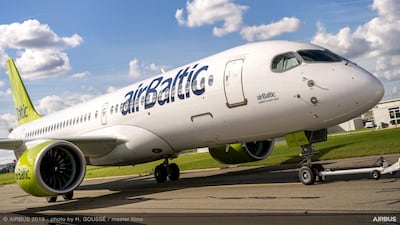The future of air travel is set to change forever with the advent of a new era of high-powered jetliners.
The ability to travel farther and faster while burning less fuel has long been a pipe dream for the aviation industry – but that could all be about to change.
The National looked at some of the new planes that are expected to be at the forefront of the next generation of flight.
Boom Supersonic Overture
The Oregon-based company Boom Supersonic is set to release the Overture in 2026. The aircraft can fly at twice the speed of sound, at Mach 2.2, but is expected to be limited to subsonic speeds of about 1,125kph over land.
It will be the first civilian supersonic jet since Concorde was retired almost 20 years ago.
The company has promised that ticket prices would not be much higher than those of a typical seat in business class.

The Overture will be able to fly from Tokyo to Seattle in four and a half hours, cutting four hours off the usual time.
A trip from Los Angeles to Sydney could be completed in eight and half hours with the Overture, instead of the standard 14.5 hours.
Its range is 8,300 kilometres.
Maveric by Airbus
The suggestion that Airbus has created a plane that looks like it belongs in a futuristic version of Top Gun will not be allayed by its name – Maveric (Model Aircraft for Validation and Experimentation of Robust Innovative Controls).
The plane, which is two metres long and 3.2 metres wide, has the potential to reduce fuel consumption by up to 20 per cent in comparison with current single-aisle aircraft.
The Maveric is designed to hold hundreds of people but experts predict a wait until 2035 before aircraft using this design are in regular use.
It is currently in the development phase but a remote-controlled prototype took flight for the first time in June last year.
The “blended wing body”, which resembles a giant bat, opens new possibilities for propulsion systems.
“Airbus is leveraging emerging technologies to pioneer the future of flight. By testing disruptive aircraft configurations, Airbus is able to evaluate their potential as viable future products,” said Jean-Brice Dumont, executive vice president of engineering with Airbus.
“Although there is no specific time line for entry into service, this technological demonstrator could be instrumental in bringing about change in commercial aircraft architectures for an environmentally sustainable future for the aviation industry.”
Airbus A220-500
The Airbus A220-500 is expected to make travelling in economy class a whole lot more comfortable.
Expected to be released in the second half of this decade, the A220-500 boasts seats at least 46cm wide, has a 2x3 seating layout and can hold 150 passengers – significantly more than existing A220s, which hold 100.
The new model also offers larger windows and spacious overhead lockers.
The A220-500 will consume less fuel than other short-haul planes, which will make brief flights more appealing to environmentally conscious passengers.
Boeing 777X
Boeing claims its new 777X will be the “world’s largest and most efficient twin-engine jet, unmatched in every aspect of performance”.
Lufthansa will launch the jet into service in 2022, two years after it was delayed because of the Covid-19 pandemic.
The 777X will carry between 384 and 426 passengers in a multi-class layout.
The aircraft will also feature dimmable windows, wider cabins and larger overhead lockers.
Expect to see this plane become a regular feature at Dubai International Airport because Emirates has ordered 150 777Xs, worth more than $83 billion. The aircraft are expected to seat 426 passengers and have a range of 13,500km.
Airbus A321XLR
Airbus’ A321XLR will be able to fly just under 8,700km non-stop. A third fuel tank means it can fly for up to 10 hours without needing to refuel, almost double the duration of other narrow-bodied planes.
Airbus says the aircraft, expected to be released in 2023, operates with a 30 per cent reduction in fuel burn per seat.
The A321XLR has a top speed of 876kph.







